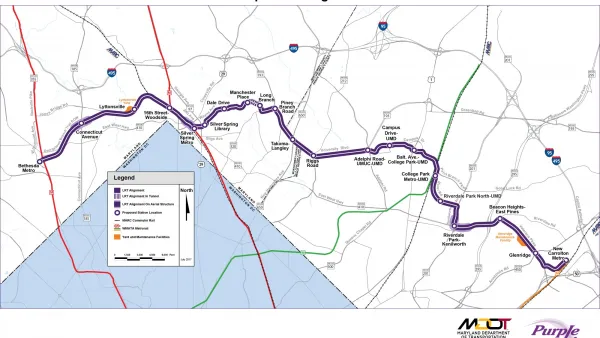To finance and construct a new $2.2 billion light rail line in the D.C. suburbs, Maryland will seek to enter into a unique private sector partnership. The ambitious strategy is drawing concern from lawmakers.
In this era of tight budgets and federal gridlock, cities and states are taking it upon themselves to find innovative ways to fund desirable infrastructure projects. Maryland is one of the states dipping its toes in the public-private partnership waters with a plan to design and build a 16-mile light rail line with the help of the private sector.
"Maryland transportation officials say such a partnership would take advantage of the private sector’s light-rail expertise and require the companies to assume the financial risks of any construction delays or cost overruns," explains Katherine Shaver. "The efficiencies gained from one private entity overseeing all aspects — from the drawing board to bulldozers to trains on tracks — are projected to save up to 20 percent over 35 years, officials say."
However, "[t]he approach, while considered innovative, is drawing scrutiny," she adds. "State Sen. Richard S. Madaleno Jr. (D-Montgomery), who reviewed the plan as a member of the Senate Budget and Taxation Committee, said he considers it a 'very risky proposition.'”
“It’s attractive. It’s an innovative approach,” Madaleno said. “But we don’t have very many, if any, examples of how this works out.”
UPDATE (10/16/13): The vote on whether to pursue the plan has been delayed until November 6.
FULL STORY: Purple Line: Public-private transit partnership would be one of the broadest in U.S.

National Parks Layoffs Will Cause Communities to Lose Billions
Thousands of essential park workers were laid off this week, just before the busy spring break season.

Retro-silient?: America’s First “Eco-burb,” The Woodlands Turns 50
A master-planned community north of Houston offers lessons on green infrastructure and resilient design, but falls short of its founder’s lofty affordability and walkability goals.

Delivering for America Plan Will Downgrade Mail Service in at Least 49.5 Percent of Zip Codes
Republican and Democrat lawmakers criticize the plan for its disproportionate negative impact on rural communities.

Test News Post 1
This is a summary

Test News Headline 46
Test for the image on the front page.

Balancing Bombs and Butterflies: How the National Guard Protects a Rare Species
The National Guard at Fort Indiantown Gap uses GIS technology and land management strategies to balance military training with conservation efforts, ensuring the survival of the rare eastern regal fritillary butterfly.
Urban Design for Planners 1: Software Tools
This six-course series explores essential urban design concepts using open source software and equips planners with the tools they need to participate fully in the urban design process.
Planning for Universal Design
Learn the tools for implementing Universal Design in planning regulations.
EMC Planning Group, Inc.
Planetizen
Planetizen
Mpact (formerly Rail~Volution)
Great Falls Development Authority, Inc.
HUDs Office of Policy Development and Research
NYU Wagner Graduate School of Public Service



























